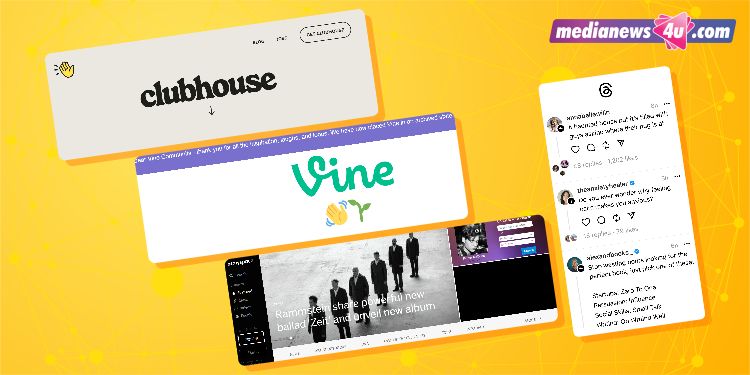The rise and fall of social media applications over the years have left a trail of dashed digital dreams. Platforms like Google+, Vine, Bebo, Friendfeed, Orkut, and more recently Clubhouse and Instagram Threads, entered the social fray with a lot of hype but haven’t emerged as the next big thing they hoped to be.
Emerging in the early 2000s, MySpace enjoyed a meteoric rise, reaching its peak in 2008 with over 100 million users worldwide. The platform’s success was rooted in its innovative approach to digital self-expression, allowing users to customise profiles and connect with friends in new ways. By 2011, it had dropped to around 34 million users. It currently has 6 million. The lack of adaptability to changing trends, a cluttered user experience and the rise of Facebook are attributed to its decline.
Google+ faced challenges despite being from the Google stable. Despite strong initial interest, it struggled to maintain user engagement. Audio chat social network Clubhouse was a buzzword during the pandemic. The platform’s usage peaked in March 2021, when it announced that it had 10 million active users. According to reports, this declined to around 60 pc of that number by 2023. Gradual easing of pandemic restrictions, competitors replicating audio chat features and the platform’s own challenges in maintaining novelty saw the tide ebb.
Adding latest to the list, Threads launched by Instagram, which witnessed 100 million sign ups initially, has seen its active user count drop by 82 per cent since launch, according to news reports published in end-July 2023. It is apparent that even established platforms cannot be sure of carving out a new niche in social media.
Why have most social media apps failed to live up to the initial hype? Could clutter of options and paucity of consumer time be reasons?
“The factors contributing to the rise and fall of these platforms are multi-faceted,” observes Kowshik Komandur, Associate Vice President with OnMobile Global.

According to Komandur, the digital age has ushered in an era of unparalleled choice, with a plethora of platforms vying for users’ attention. The sheer abundance of options creates a phenomenon known as ‘option paralysis’, wherein users become overwhelmed by choice and end up switching between platforms without truly engaging on any, he explains.
“A study conducted by Nielsen in 2018 revealed that, on average, American adults spent over 11 hours per day consuming media. This figure highlights the paucity of consumer time, as individuals struggle to balance the demands of work, personal life, and digital engagement. Furthermore, the dynamic nature of technology ensures that what is innovative today can quickly become outdated tomorrow. As user preferences evolve and technological advancements march forward, platforms must remain agile to remain relevant. For instance, the demise of Vine can be attributed, in part, to its inability to evolve beyond its initial short-form video concept. On the other hand, platforms like Instagram have thrived by consistently introducing new features that align with evolving trends and user expectations,” he adds.

“The allure of novelty cannot mask an app’s fundamental shortcomings. Blaming it solely on the clutter of options or consumers’ time constraints would be oversimplification,” opines Atrayee Chakraborty, Knowledge and Strategy Partner, Lodestar UM.
She adds, “Users are discerning, seeking value in every interaction. While competition is fierce, merely offering another clone won’t cut it. Successful apps cater to real needs, flaunt impeccable UI/UX, and build genuine connections with users. It’s not about the quantity of options, but the quality that stands the test of time.”

In Ipsos Country Chief Client Officer Geeta Lobo’s opinion, social media apps either fail to build up a critical mass of subscribers, or having done that (as in case of Threads), fail to sustain the active user base.
“The former can happen if the core idea of the platform has no distinctive pull or if the marketing push in the launch phase is inadequate or in some cases with data privacy issues. Having built a subscriber base successfully, to have the users coming back, you have to keep innovating and stay on top of trends. And sometimes the user experience itself may get in the way of what draws people in. Fixing those and offering new hooks to return is a constant effort,” Lobo says.

“These apps often burst onto the scene with all the fireworks of a New Year’s eve celebration. But just like those resolutions to hit the gym, the enthusiasm fades quickly. They forget to bring innovation to the party, so everyone’s like, “Hey, we’ve already got plenty of apps that show us what people had for breakfast, thanks.” Many social media apps are just copycats of existing apps, offering little to no new features or functionality. This makes it difficult for users to justify switching to a new app, especially when they are already invested in their existing social networks. Not all social media apps are created equal. Some apps are designed to serve a specific need, while others are more general-purpose. If an app does not address a need that users have, it is unlikely to be successful,” observes Vishal Rupani, Co-founder, Sprect.
According to N Chandramouli, CEO at TRA Research, new subscribers to any new social media platform, especially if seems to have a unique offering, will find everyone clamouring to join in because of the FOMO effect. There is the fear of it becoming the next big thing.

“But in the initial days of usage, the user gets to understand if the platform has any uniqueness, some features that suit their individual needs, and if not, they revert back to their favourite platforms. While some copycat platforms like YouTube Shorts (to counter TikTok) have been successful, it’s only because the existing YouTube creators find it easier to load up short content on the same platform. However, if you expect a Twitter user to change to Threads with no differentiator at all, that was an unlikely possibility. In the case of Clubhouse, people were happy to ‘hear’ others during the pandemic, but as a rule the generation on social media would rather type than speak,” reflects Chandramouli.
So, what will it take to grow a social interaction app’s base today and make it a daily habit?
According to Rupani, besides having ultra-deep pockets, to grow a social interaction app’s base and make it a daily habit, it’s crucial to offer a unique value proposition that sets the app apart from competitors. Simplicity and usability are paramount, ensuring an intuitive interface that encourages effortless interaction.
Rupani adds, “Consistent updates based on user feedback and evolving preferences demonstrate the app’s responsiveness and commitment to improvement. Incentives like rewards, recognition and exclusive content incentivise user engagement, making the app a part of users’ daily routine. The app should prioritise data privacy and security, ensuring that users feel comfortable sharing information and engaging in conversations without fear of misuse. Lastly, staying attuned to emerging trends and integrating innovative features keeps the app relevant and appealing to tech-savvy users.”
In Chandramouli’s opinion, any new social media platform will have to ensure that it fulfils a unique, unmet need.
“In the case of Twitter, it allowed users to quickly share their posts forcing them to reduce the size of the post, ensuring the reader is not inundated with big content. Its unique feature ensured brevity. Big Tech may want to try different apps, like Google+ did, but Zoom came up and did what no one could imagine, becoming the de facto video calling app for most, because of its easy, no-fuss interface. While there is no standard formula for success, understanding the customer is going to be the way that newer social media apps can hope to get and retain active users,” he surmises.
In Lobo’s opinion, the app has to offer a compelling and a distinctive reason for the users to return.
She notes, “Habits form if there are basic functional needs that are addressed of course but more than that when it meets some innate motivation. The need for validation or social connections and so on. So the app has to offer a compelling and a distinctive reason to return. Which is harder to do now with all the clutter of options. The user interface is also an important aspect because the mind gravitates towards effortless experiences. And the needs in the social networking space are quite dynamic. Even with the inertia of habits an app that doesn’t refresh itself can find its active user base declining.”
Growth Secrets
Chakraborty points out five features that will help social apps of today to survive.
She explains: “Unique Value: The mantra for growth lies in offering a unique experience, firmly grounded in deep consumer insights. Think Discord: A testament to niche targeting done right. Simplicity and Speed: In a world of fleeting attention spans, complexity is the enemy. Swift loading times and Clutter-free interfaces are paramount.
Visual Charm: Appealing UI/UX is no longer a luxury; it’s a necessity that lures users in. Ecosystem Integration: Bridging the gap between apps within a user’s ecosystem is essential. Seamlessly become a part of their digital life. Incentives for Engagement: Exclusive content and features are the hooks that keep users coming back. Building a habit demands a continuous offering of value.”
“Growing a social interaction app’s user base and turning it into a daily habit requires a strategic approach,” opines Komadur.
He explains,” first and foremost, the app must offer a clear and compelling value proposition that addresses a specific need or pain point for users. This differentiation can foster initial interest and drive downloads. However, sustaining engagement requires more than just a novel concept. The app’s user experience must be intuitive, seamless, and aesthetically pleasing. Instagram’s success can be attributed in part to its user-friendly interface and constant optimisation.”
According to him, to cultivate a dedicated user base, community building is paramount.
“Platforms like Facebook and Reddit have thrived by creating spaces where users can connect, share and engage in meaningful discussions. Moreover, personalisation plays a pivotal role. According to a study by SmarterHQ, 72 percent of consumers say they now only engage with marketing messages that are personalised and relevant to their interests. Utilising data-driven insights to tailor content and recommendations can enhance user experience and keep them coming back,” he adds.
“In terms of marketing, a multi-pronged approach is essential. Social media advertising, influencer collaborations and content marketing can all contribute to spreading awareness and driving user acquisition. However, the strategy must also encompass adaptability. The digital landscape is in constant flux, with new platforms and features emerging regularly. A successful app must be prepared to pivot and evolve to remain aligned with user preferences and changing trends,” concludes Komandur.
Feedback: [email protected]

















